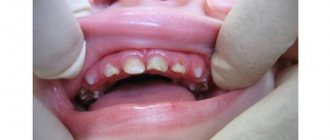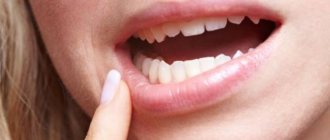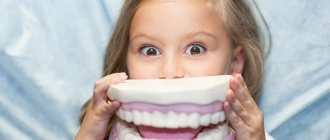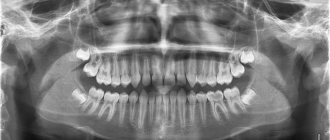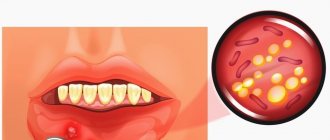Pulpitis is the inflammation of the pulp, the tissue located inside the tooth. This disease poses a fairly serious threat to the child’s body as a whole. Therefore, it should be taken as seriously as possible.
For those who doubt whether pulpitis of baby teeth occurs in general, we will answer unequivocally: it happens. And besides, it usually progresses much faster than in adults. In children, the hard dental tissues are thinner, and the dentinal tubules, on the contrary, are wider, which leads to the rapid development of infection inside the teeth. Therefore, in childhood, this disease much more often acquires a chronic form with all the ensuing consequences.
Why does pulpitis of a baby tooth occur? How to detect it? And what should parents do if this misfortune befalls their dear child?
Causes of pulpitis of primary teeth in children
Most often, according to dentists, this very unpleasant disease in childhood is caused by:
- If caries treatment is not carried out on time - in this case, microbes developing in the carious cavity and tooth tissue disintegrating under their influence provoke the active release of toxins. Under their influence, the inflammatory process of the pulp most often begins, which, if left untreated, can lead to very serious consequences.
- An acute infectious disease suffered by a child - during the course of an infection, tooth pulpitis in a child, as a rule, occurs against the background of decreased immunity and the appearance of a large number of bacteria.
- Injury to a baby tooth - this can be either an accidental damage to the tooth during play or rest, or too rough treatment of the oral cavity in the presence of caries, or even a careless action of the dentist;
- Medical errors in the treatment of caries - inflammation of the pulp can develop under the influence of incorrectly selected filling material or as a result of treating the oral cavity with too strong antiseptics, for example, alcohol, as well as due to overheating of dental tissues during the preparation of a carious cavity.
Incidence of pulpitis
Many parents do not take their children to the dentist, believing that pulpitis cannot develop in a child at 2 years old. Mothers think that if they don’t give their baby sweets, then caries won’t affect the enamel. Unfortunately, they are wrong. Tooth pulpitis can strike a child at 2, 3, or 5 years of age.
- At 2 years of age, pulpitis affects the baby's front teeth;
- From 3-4 years of age, children more often suffer from pulpitis in the back teeth. Often a 4-5 year old child comes to the dentist crying from pain in his molars. Surprisingly, such inflammations occur several times more often than pulpitis in the front teeth of children.
Methods for diagnosing traumatic pulpitis
Any dental disease requires immediate medical intervention, and pulpitis is no exception in this regard. Ignoring the problem will lead to serious complications.
An adequate therapeutic regimen is based on the diagnosis, for the accuracy of which different methods are used today:
- visual examination of the oral cavity during the first visit;
- radiography;
- radiovisiography;
- CT;
- electroodontodiagnostics.
The latter technique is based on the reaction of teeth when they are exposed to alternating current. Electroodontometry is prescribed as an alternative to radiography or as a supplement to it. A comprehensive study allows you to most accurately identify the problem and determine the degree of damage to dental tissues. This approach will ensure proper treatment and complete restoration of the tooth.
What symptoms indicate pulpitis of primary teeth?
The following will help you tell if your child has pulpitis:
Complaints about toothache
As a rule, it worsens in the evening and at night, as well as during the process of chewing food. There is almost always a reaction to cold or hot drinks. Painful sensations may occur when tapping the tooth. With an exacerbation of the inflammatory process, the pain becomes aching and constant.
However, it should be borne in mind that the rapid transition of the disease into a chronic form, characteristic of childhood, often leads to the disappearance of pain. Which does not mean there is no problem. And you should visit a doctor even if the tooth stops hurting.
Cheek swelling (swelling)
This symptom can often be found in photographs of pulpitis in baby teeth. However, it is not always observed. And, in addition, it can signal diseases such as periodontitis or periostitis. But pulpitis should not be ruled out. Only a doctor can make an accurate diagnosis. And you may have to take an x-ray.
Increased body temperature and deterioration of general condition
If the child has a strong immune system, then a high temperature may also indicate the development of the disease. In this case, the body reacts to the inflammatory process that began in the pulp. And if there are no suspicions of other diseases accompanied by an increase in body temperature, be sure to show the child to the dentist.
If your baby has a toothache, or you observe any of the above symptoms, you should immediately visit a doctor. Perhaps it's time to start treating baby tooth pulpitis. In any case, there is definitely a reason to visit the dentist’s office.
Acute pulpitis. Types and symptoms
Acute pulpitis in children is diagnosed very rarely. This is due to the fact that due to the structural features of milk teeth (in particular the root system), it very quickly becomes chronic. The acute form has the most pronounced symptoms, so it is important for parents not to miss the moment and, if characteristic symptoms are present, immediately take the child for examination to the dentist.
- Severe and sudden toothache, worse at night.
- Painful sensations when pressing, eating, exposure to cold and hot.
- Weakness, headache, fever.
- Swelling in the area of the diseased tooth.
- Enlarged lymph nodes.
- Purulent discharge (rarely observed).
According to the degree of spread, acute pulpitis of primary teeth is divided into focal and diffuse. In the first case, the disease affects only a small area of the pulp, in the second - both the coronal and root. It is almost impossible to detect pulpitis at the focal stage, since it covers the entire pulp of a baby tooth literally in a matter of hours. At an advanced stage, acute pulpitis can develop into two of the most dangerous forms.
- Serous pulpitis.
Occurs when serous fluid accumulates in the canals. - Purulent pulpitis.
It is a continuation of the serous stage. There is an accumulation of purulent exudate in the pulp chamber, which can result in the formation of an abscess. Purulent acute pulpitis in children is usually accompanied by aching pain (can be felt in other parts of the jaw and head), fever and swelling of the tissue in the affected area.
How to treat pulpitis of baby teeth
If you suspect that your son or daughter is suffering from this particular illness, then the best thing to do is to seek professional help as soon as possible. Because the disease is quite serious, and it requires correct diagnosis and qualified medical intervention.
There is no need to remove the tooth at all. Moreover, early removal can lead to the formation of an incorrect bite. The course of treatment of pulpitis in children largely depends on the stage of tooth development at which it is detected.
The fact is that the pulp can be completely removed only in the formed roots (and this takes several years from the moment the tooth erupts). Therefore, in most cases, the doctor removes the pulp only partially. As a rule, carious lesions are removed simultaneously with its part located in the crown of the tooth. This procedure is carried out after an anesthetic injection. After that, a medicine is placed at the bottom of the cavity and at the mouths of the canals, designed to disinfect the remaining tissues. Or, the pulp is first mummified, also through the application of drugs, and then removed.
Over time, such a “gasket” of medications is replaced or left under a permanent filling.
In case of pulpitis of milk teeth, first of all, it is necessary to eliminate the inflammatory process and prevent complications in the form of periodontal damage, which can cause improper formation of permanent teeth. There are 3 main methods in total.
Biological method of treating pulpitis in children
Several years ago, dentists began to practice conservative methods of treating pulpitis in children. This conservative therapy does not require surgical intervention, is easier for the baby to tolerate and causes minimal complications.
Conservative treatment of pulpitis of primary teeth is carried out in stages:
- The doctor opens the inflamed cavity.
- Covers the bottom of the gum and pulp with a special mixture consisting of Shostakovsky balm, calcemin and artificial dentin.
- After the mixture dries, the dentist seals the tooth using fluorine cement or phosphate cement spacers.
Doctors are ambivalent about such a procedure. Some consider biological treatment of pulpitis in children to be an excellent way to relieve the child of pain and create the most favorable conditions for the development of the apices of the roots of permanent teeth.
Many dentists believe that it is the conservative method of treating pulpitis of baby teeth that can provoke various periodontal inflammations.
In any case, treatment of pulpitis of primary teeth requires repeated visits to the doctor and a serious approach. Therefore, be persistent and patient, and also try to set up your child correctly so that every trip to the clinic does not become stressful.
Please note that there is no general approach here. The inflammatory process occurs differently each time. And only a doctor can decide how to treat pulpitis of a baby tooth in each specific case.
Possible mistakes when treating pulpitis
Unfortunately, it is not at first glance that tooth pulpitis in a child is a simple ailment. Incorrect treatment can provoke nightmares such as periodontitis, periostitis and even acute polio.
The most common mistakes when treating pulpitis in children are:
- Incorrect assessment of the condition of the pulp and, consequently, partial removal of inflammation. In this case, the baby will very soon suffer from a new exacerbation.
- Loose bandage when removing pulp. In rare cases, doctors do not apply a temporary bandage with arsenic tightly enough, which can lead to burns and necrosis of the tissues of the cheek, tongue and mucous membranes.
- An overdose of arsenic can cause acute periodontitis, which requires longer treatment than pulpitis in a child.
- Trauma to the periodontium with a root needle. Incomplete cleaning of root canals during the treatment of acute or chronic pulpitis in children can also provoke periodontitis.
Treatment of pulpitis of teeth with unformed roots
The root system of a baby tooth is formed over a long period of time after eruption, so there are often situations when caries begins to form on a tooth whose roots have not yet closed the apex. This leads to some treatment difficulties:
- short roots and wide channels;
- the upper part of the root is the “growth” zone, injury to which is an obstacle to root formation;
- the likelihood of infection of the permanent tooth germ;
Treatment of pulpitis of teeth with immature roots in children requires special care. The doctor must carefully monitor that the filling material is not carried beyond the expansion of the root apex. It is worth noting that complete removal of the pulp and treatment of the canals is impossible - the optimal solution here is vital and devital extirpation. Pulp amputation may also be used. The biological method, which consists in preserving a viable pulp and relieving inflammation, is also practiced quite often. Its essence is to prepare the tooth, apply a medicinal paste with calcium hydroxide, after which the tooth is filled with temporary material. A few days later, if there are no complications and the unpleasant symptoms disappear, the doctor installs a permanent filling.
Treatment of pulpitis: how to adjust a child
Pulpitis of baby teeth causes a lot of trouble for the baby. There is no need to aggravate the already difficult days of the child; parents should definitely prepare him for a visit to the dentist.
Talk to the baby. Explain that the doctor will treat tooth pulpitis carefully and the patient will not feel pain. It is important that the child does not associate going to the dentist with torture chambers. Choose a positive doctor whom you trust, and dental treatment will become an exciting attraction.
The main task of parents is not to let the disease take its course. Since chronic pulpitis of the baby tooth, which is most often seen in the photo, can lead to further spread of the inflammatory process and damage to the rudiments of permanent teeth.
And don’t forget that preventing trouble is always easier. Therefore, do not allow pulpitis. Ensure that your child brushes their teeth correctly and regularly using high-quality oral hygiene products. And be sure to visit your dentist regularly.
ASEPTA BABY toothpaste for babies from 0 to 3 years old will help you quickly teach your baby to brush their teeth. The soft gel carefully cares for your teeth, reliably protecting them from caries. And the sweet taste of tutti-frutti makes the procedure pleasant and tasty.
Prevention of pulpitis
To prevent any dental diseases, including pulpitis, there are a number of standard recommendations:
- It is necessary to rinse your mouth after every meal, especially after sweets and starchy foods.
- A visit to pediatric dentistry every six months will allow you to identify caries and other problems in the early stages, eliminate the problem in a timely manner, and avoid complications.
- The child must learn to brush his teeth strictly 2 times a day with a good toothpaste and the right brush.
- It is important to show the child to a specialist for any, even minor, complaints from the child about pain or discomfort in the oral cavity.
- Do not frighten children with doctors; try to develop a positive perception of the dentist in your child. If a child is not afraid of a doctor, he will not only allow himself to be examined calmly, but will also tell his parents in time about the first painful symptoms.
- Once a month, independently conduct a preventive examination of the child’s oral cavity for the presence of caries or pulpitis of baby teeth. If you have any suspicion, visit your doctor and get a photo-x-ray.
Only a doctor can recommend which is better, to treat or remove a baby tooth affected by pulpitis: first of all, you need to go to a dental clinic. It all depends on the stage of tooth decay, the shape and type of the ongoing disease.
A baby tooth that is not treated in time can not only cause complications, but also affect the germ of a permanent molar with caries.
Pulpitis of permanent teeth in children
Pulpitis of permanent teeth in children is a common ailment among adolescents. Surprisingly, newly erupted molars are especially sensitive to external influences, because during the first few years they are not yet saturated with mineral components.
Pulpitis of permanent teeth in children most often develops against the background of deep or medium caries. And if in children with formed tooth roots, pulpitis develops in the same way as in adults, then in adolescents with just developing roots, this ailment is significantly different from what is usual for parents.
Alarming symptoms after treatment
In the first few days after treatment, parents should be alert to the following signs of complications:
- The child complains of pain in the treated tooth. The important thing here is to wait a while. If the pain gradually subsides during the first day, then there is nothing special about it. This is the body’s reaction to interference and irritation of the mucous membrane. You should be alert to pain that appears after a few days , when the tooth no longer hurts, or pain, the intensity of which does not decrease, but increases;
- Fever. A slight increase in temperature on the first day is quite possible due to stress experienced by the child. Parents should closely monitor his condition, and if it happens that the temperature reaches 38 degrees, urgently show the child to a doctor.
Symptoms of pulpitis of permanent teeth in children
Acute pulpitis
Features of pulpitis in permanent teeth with incomplete growth include:
- Spontaneous pain. Children complain of unexpected, mild pain in the mouth. Unpleasant sensations arise suddenly, for no apparent reason. The pain can torment a teenager for hours, or it can go away on its own in 15-20 minutes. Often, various irritants, such as cold or hot food, cause discomfort.
- With acute diffuse pulpitis of permanent teeth in children, discomfort intensifies in the evening and at night. Soon the pain becomes constant, radiating to the temple, back of the head, ear or infraorbital area. Very soon, painkillers become ineffective.
- Softened dentin of the carious cavity, weakly pigmented, also indicates tooth pulpitis.
- Acute throbbing pain radiating to the trigeminal nerve is also a symptom of acute purulent pulpitis with incomplete root formation. It is noteworthy that the pain intensifies when consuming hot food or drinks and is relieved by cold food.
Chronic pulpitis
Chronic pulpitis of permanent teeth with unfinished growth, as in baby teeth, can occur as a primary process without an acute stage. The following symptoms are characteristic of chronic inflammation:
- Aching spontaneous pain;
- Unpleasant sensations when eating or pressing on a tooth;
- Prolonged pain from cold or hot food;
- Pulp bleeding.
Chronic gangrenous or fibrous pulpitis of permanent teeth in children can occur in both open and exposed pulp chambers. Fibrous inflammation is characterized by a dark red chamber that bleeds unpleasantly when touched. Gangrenous pulpitis is usually accompanied by gray-green discharge with a putrid odor.
Chronic pulpitis in children goes away sluggishly, the pain returns every now and then. A teenager complains of attacks of pain spreading along the trigeminal nerve.
Treatment of pulpitis of permanent teeth in children
Doctors distinguish two methods of treating pulpitis in permanent teeth. At the discretion of the doctor, therapy is carried out with partial or complete preservation or removal of the pulp. Let's look at each method in more detail.
Conservative treatment
“A living tooth has a better chance of survival than a dead one” - you’ve probably heard this common and, of course, fair phrase. Recently, dentists have mastered the biological method of treating pulpitis of permanent teeth in children, which is recommended for diseases such as:
- Pulp hyperemia;
- Traumatic pulpitis;
- Acute serous pulpitis;
- Chronic fibrous pulpitis without destruction of periodontal tissue;
- Acute pulpitis, lasting no more than a day;
Unfortunately, science has not yet moved that far forward, and biological treatment of pulpitis is effective when the child is in good condition and has a shallow carious cavity.
For adolescents with incomplete root formation, dentists treat pulpitis using the method of partial nerve preservation. This method helps complete the formation of the root system.
Chronic pulpitis of temporary teeth
Chronic pulpitis occurs as an outcome of acute pulpitis, but more often develops gradually, bypassing the acute stage. A. I. Abrikosov explains the possibility of the primary occurrence and development of chronic pulpitis by the anatomical and physiological characteristics of the pulp, wide tubules, and a large apical opening, which contribute to a good outflow of exudate from the inflamed pulp.
There are cases of chronic pulpitis in intact molars as a result of incomplete dislocation or bruise of a tooth, when there is a rupture of the neurovascular bundle at only one root. This leads to disruption of pulp nutrition, initially only in this root, and then in its coronal part.
Chronic forms of pulpitis occur much more often than acute forms in both temporary and permanent teeth in children of any age.
In temporary teeth, chronic pulpitis was found in 79.4% of cases, and in permanent teeth - in 83.4%. In temporary teeth, of the three forms of chronic pulpitis, fibrous pulpitis is more common, then gangrenous and very rarely hypertrophic pulpitis. Due to the fact that chronic proliferative and hypertrophic pulpitis differ only in the duration of development and the methods of their treatment are identical, it is advisable to combine them into one form - chronic hypertrophic pulpitis.
Chronic pulpitis in 40-60% of cases is accompanied by chronic, predominantly granulating periodontitis, which requires mandatory X-ray monitoring of the periapical area of the teeth in case of chronic inflammation of the pulp.
Chronic pulpitis of temporary teeth is observed both with an open (60.5%) and a closed (39.5%) tooth cavity. The clinical course of pulpitis in temporary teeth is characterized by a less pronounced pain reaction than in permanent teeth. This, apparently, is explained not only by the good outflow of inflammatory exudate from the source of inflammation, but also by the fact that the pulp of temporary teeth contains a smaller number of nerve elements than in permanent teeth, and therefore, the pain reaction to various pathogenic agents is less pronounced, especially during the period of resorption of the roots of temporary teeth.
Chronic pulpitis manifests itself as pain when exposed to thermal, mechanical and chemical factors. Causal pain in chronic pulpitis is detected only in 44% of children; in the rest it is asymptomatic. There are no painful sensations in teeth in which carious cavities are located in areas of the tooth that are difficult for the irritant to penetrate (proximal surfaces), as well as in cases of significant degenerative changes in the pulp. The intensity of pain depends on the degree of change in the pulp. In the early stages of its chronic inflammation, pain in the pulp is more pronounced. As pathological changes develop, its response to external influences weakens. The pain can also be spontaneous. It occurs when conditions for the outflow of exudate worsen. The possibility of its occurrence must be taken into account in differential diagnosis with acute pulpitis.
Chronic pulpitis can be accompanied by acute or chronic inflammation in the periodontium, lymphadenitis and intoxication of the body. These complications are most often found with gangrenous pulpitis . With this course, the clinical picture of chronic pulpitis is dominated by symptoms of acute or chronic periodontitis.
Chronic fibrous (simple) pulpitis. With this type of pulpitis, children complain of pain that occurs during meals and persists for different periods of time (from several minutes to several hours). The intensity of pain depends on the duration of the disease and the degree of degenerative changes in the pulp. Due to the pain caused by food getting into the carious cavity, children avoid using the side on which the diseased tooth is located when eating. This is noted not only by the child, but also by the doctor during examination, who reveals inflammation of the cheap edge and deposits on the teeth that are not involved in the act of chewing. This form can also be asymptomatic.
The pain can be of varying intensity depending on the degree of changes in the pulp: the more significant the disturbances in its structure, the less the pain.
Radiographs of teeth with chronic fibrous pulpitis indicate an expansion of the periodontal gap in 8-13.6% of cases. An exacerbation of this form of pulpitis is possible.
It is necessary to differentiate chronic fibrous pulpitis from chronic deep caries, chronic gangrenous pulpitis and chronic periodontitis. It is difficult to differentiate fibrous pulpitis from gangrenous pulpitis if the tooth cavity is not opened. The diagnosis is clarified by using cold and thermal stimuli, and water should penetrate into the carious cavity of only the tooth being examined. If it also irrigates neighboring teeth with carious cavities, it can cause a similar reaction in them. To avoid this, the tooth should be isolated with a cotton swab. Hot or cold water should be applied to the tooth in drops or using cotton swabs, but not in a stream. EDI diagnostics helps to clarify the disease in teeth with formed roots, and in young children, applying a bandage without a medicinal substance.
Chronic gangrenous pulpitis. Occurs frequently, especially in primary teeth. Develops from acute general or chronic fibrous pulpitis. Tooth pain with this form of inflammation does not always occur. Complaints mainly boil down to a feeling of heaviness in the tooth, a feeling of awkwardness, and “bloating.” Pain appears during eating under the influence of sudden temperature fluctuations, often from hot foods. It does not occur immediately after exposure to the stimulus. This indicates necrosis of the surface layer of the pulp and degenerative changes in its nerve receptors in the preserved part.
With chronic gangrenous pulpitis, the color of the tooth may change. With a deep cavity, a connection with the tooth cavity is possible, through which either a gray pulp or a brown mass of decay is visible. Pulp pain of varying intensity. Often older children notice an unpleasant odor from their teeth. This is due to the putrefactive decay of pulp areas under the influence of anaerobes.
Gangrenous pulpitis occurs during the period of resorption of the roots of temporary teeth. This is confirmed by clinical data. Considering the conditions for the development and spread of the inflammatory process in the pulp of temporary teeth, especially at an older age, we should speak, obviously, not of gangrenous pulpitis, but of pulp gangrene. Gangrenous pulpitis in primary teeth is a very rare disease. During the period of root resorption, pain during deep probing may be due to granulations that have grown in the canal area. There may be a fistula on the gum according to the projection of the root apex. Regional lymph nodes are enlarged and slightly painful. In chronic forms of pulpitis - fibrous and, especially, gangrenous - changes in the periodontium and bone, as well as at the root apex and in the area of bifurcation of molars, are detected radiographically.
The clinical picture of pulpitis often does not correspond to the condition of the periapical tissues, especially in the chronic gangrenous form.
Chronic gangrenous pulpitis should be differentiated from chronic fibrous pulpitis and chronic periodontitis, in the absence of complaints and a shallow carious cavity - from average caries, and with an exacerbation of the process - from acute general pulpitis, acute periodontitis, exacerbation of chronic periodontitis.
T. F. Vinogradova (1968) notes that in 62% of children with chronic pulpitis of primary teeth the process ends in periodontitis.
Chronic hypertrophic pulpitis. Chronic proliferative pulpitis is often diagnosed in the hypertrophy stage. It occurs relatively rarely in childhood. Chronic proliferative pulpitis usually develops from chronic fibrous pulpitis in cases where the crown is severely destroyed, the pulp is exposed and is subject to constant mechanical irritation and infection. Percussion of the tooth may be sensitive, but this symptom is not constant and leading to this disease. On the radiograph, no major changes in the bone tissue are noted at the apexes of the roots. An X-ray examination of pulpitis in primary teeth reveals that in 57% of cases, pulpitis is accompanied by destructive changes in the periodontal tissues. In this case, the predominant form is chronic granulating periodontitis.
Chronic hypertrophic pulpitis should be differentiated from a gingival papilla that has grown into a carious cavity, periodontal granulation tissue that has entered the tooth cavity through a perforation in the bottom or wall of the tooth, or through the mouths of the canals of resorbed roots in chronic granulating periodontitis.
Treatment of chronic pulpitis
Up to 4 years of age, primary chronic pulpitis predominates, developing in the upper incisors and lower molars, in teeth with congenital malformations of the dental tissue - in this case, vital amputation is used.
With acute primary chronic pulpitis at this age, the roots of the teeth have not formed, the rudiments of permanent teeth are as close as possible. The cavity of the pulp chamber is extensive, the root canals are wide and short. The pulp tissue is morphologically and functionally immature, therefore, in the treatment of pulpitis, devital amputation is used, followed by mummification of the pulp in 3 visits.
At the age of 4-6, as a rule, acute pulpitis occurs; the roots of the teeth have formed during this period.
Indirect pulp capping. Clinically asymptomatic and without radiographic evidence of pathology, deep carious cavities can be gradually prepared and treated using indirect pulp capping. Indirect closure is limited to teeth that have a thin, intact, uninfected layer of dentine above the pulp. Treatment is carried out under local anesthesia using a rubber dam. The carious dentin above the pulp is completely and carefully excavated. Next, indirect closure is carried out with the application of calcium hydroxide or zinc oxide eugenol cement to the pulp area and filling of the tooth with a dense temporary filling to prevent bacterial infection. Indirect pulp capping is considered successful if after 6 months. Neither clinical nor radiological symptoms of pathology were identified. Now the tooth can be finally filled.
Direct pulp capping. Direct pulp closure has very limited indications, which is associated with the rapid development of the pathological process in children and insufficient formation of tertiary dentin, resulting in completely asymptomatic degeneration and pulp necrosis. Direct closure should only be performed when the pulp of primary teeth is exposed to a point.
The procedure of direct pulp protection has been widely used for many years, but still remains the method of choice for the treatment of pulpitis. Although some dentists consider it ineffective, others report excellent results with this technique in properly selected cases.
The direct pulp protection technique should be used only when there is a small opening of the tooth cavity as a result of trauma or during the preparation of a carious cavity, as well as in cases of pinpoint exposure of the pulp surrounded by a layer of intact dentin. This method of treatment is recommended only if there is no pain or discomfort during eating. In addition, bleeding from the opened pulp should be absent or moderate, which indicates the absence of hyperemia and intense inflammatory process in the pulp.
All procedures must be performed on a clean surgical field using sterile instruments. A rubber dam helps prevent pulp contamination. Peripheral carious tissue should be removed before treating areas where the tooth cavity is more likely to be exposed. In this way, most of the infected tissue is removed before the pulp is exposed. Studies by Kakehashi, Stanley and Fitzerald, as well as Walshe, discussed below, support the importance of a clean surgical site and minimizing bacterial contamination of the pulp.
Calcium hydroxide remains the standard material for protective coating of living pulp. It stimulates reparative processes in the pulp well. Hardening calcium hydroxide based gasket materials should be used. In small teeth (such as the first primary molar), hardening calcium hydroxide can also serve as a sealant for restorations.

